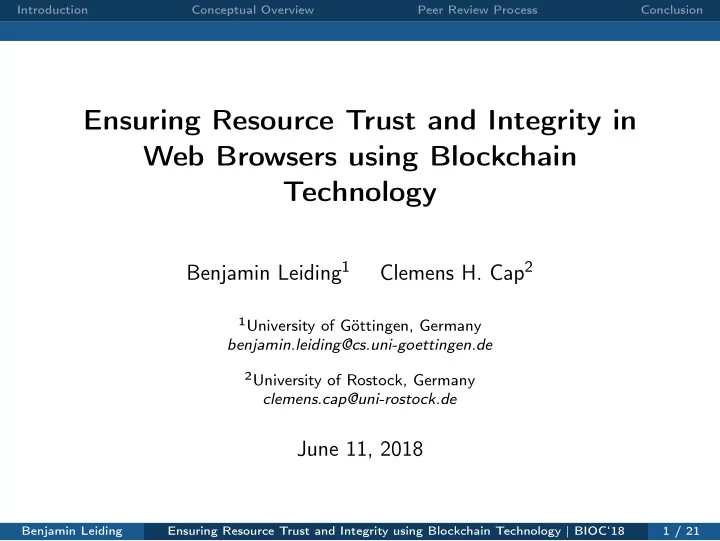

Introduction Conceptual Overview Peer Review Process Conclusion Ensuring Resource Trust and Integrity in Web Browsers using Blockchain Technology Benjamin Leiding 1 Clemens H. Cap 2 1 University of Göttingen, Germany benjamin.leiding@cs.uni-goettingen.de 2 University of Rostock, Germany clemens.cap@uni-rostock.de June 11, 2018 Benjamin Leiding Ensuring Resource Trust and Integrity using Blockchain Technology | BIOC‘18 1 / 21
Introduction Conceptual Overview Peer Review Process Conclusion About Me Academic • PhD student (University of Göttingen, Germany) • Security/Privacy background • Current research areas: • (Self-Sovereign) identity systems and authentication protocols → Authcoin protocol. • Architectures and designs of blockchain systems and applications. • Application of blockchain technology, e.g. Blockchain-based academic peer-review systems. • M2M economy among autonomous agents Benjamin Leiding Ensuring Resource Trust and Integrity using Blockchain Technology | BIOC‘18 2 / 21
Introduction Conceptual Overview Peer Review Process Conclusion Overview 1 Introduction 2 Conceptual Overview 3 Peer Review Process 4 Conclusion Benjamin Leiding Ensuring Resource Trust and Integrity using Blockchain Technology | BIOC‘18 3 / 21
Introduction Conceptual Overview Peer Review Process Conclusion Introduction Benjamin Leiding Ensuring Resource Trust and Integrity using Blockchain Technology | BIOC‘18 4 / 21
Introduction Conceptual Overview Peer Review Process Conclusion Introduction Source: https://www.whisperkey.io Benjamin Leiding Ensuring Resource Trust and Integrity using Blockchain Technology | BIOC‘18 5 / 21
Introduction Conceptual Overview Peer Review Process Conclusion Problem Statement Figure: Server-side code poising attack. Benjamin Leiding Ensuring Resource Trust and Integrity using Blockchain Technology | BIOC‘18 6 / 21
Introduction Conceptual Overview Peer Review Process Conclusion State of the Art • Checking incoming JS manually? • Disabling JS? • CDN subresource integrity via hash-codes → Only protects against attacks from the CDN, not the server/programmer. Benjamin Leiding Ensuring Resource Trust and Integrity using Blockchain Technology | BIOC‘18 7 / 21
Introduction Conceptual Overview Peer Review Process Conclusion Conceptual Overview Benjamin Leiding Ensuring Resource Trust and Integrity using Blockchain Technology | BIOC‘18 8 / 21
Introduction Conceptual Overview Peer Review Process Conclusion General Overview Benjamin Leiding Ensuring Resource Trust and Integrity using Blockchain Technology | BIOC‘18 9 / 21
Client Request Processing BPMN representation of the local client requesting and processing an incoming file.
Introduction Conceptual Overview Peer Review Process Conclusion Peer Review Process Benjamin Leiding Ensuring Resource Trust and Integrity using Blockchain Technology | BIOC‘18 11 / 21
Introduction Conceptual Overview Peer Review Process Conclusion Peer Review Review Report • ID • Project name • Project description • Link to resource/repository • Hash of the reviewed committed version • Resource itself • Reviewer information (ID, etc.) • Detailed report on review results • Boolean value → secure vs. insecure Similar to academic peer-review process. Benjamin Leiding Ensuring Resource Trust and Integrity using Blockchain Technology | BIOC‘18 12 / 21
Introduction Conceptual Overview Peer Review Process Conclusion Conflict Resolution What is a good and objective criteria for insecure code? How to settle disputes on what constitutes a vulnerability? Benjamin Leiding Ensuring Resource Trust and Integrity using Blockchain Technology | BIOC‘18 13 / 21
Introduction Conceptual Overview Peer Review Process Conclusion Conflict Resolution - CVEs The Common Vulnerabilities and Exposures (CVE) system provides a reference-method for publicly known information-security vulnerabilities and exposures. Benjamin Leiding Ensuring Resource Trust and Integrity using Blockchain Technology | BIOC‘18 14 / 21
General Overview
Introduction Conceptual Overview Peer Review Process Conclusion Incentive Mechanism • Incentive for user: • Enhanced security • Incentive for reviewer: • Rewards (Steem 1 -like token system) • Reputation • Bounties by developers/users • Incentive for programmer/software provider: • Enhanced security of product based on external reviews. • Trustworthiness 1 https://steem.io/ Benjamin Leiding Ensuring Resource Trust and Integrity using Blockchain Technology | BIOC‘18 16 / 21
Introduction Conceptual Overview Peer Review Process Conclusion Issues and Disadvantages • Depending on the stake-size, it might be still worth loosing the stake to launch a successful attack. • Incentivize reviewers. • Not all vulnerabilities are listed as CVEs. • Definition of vulnerability or insecure code. • Small and unknown projects might not be reviewed at all. Benjamin Leiding Ensuring Resource Trust and Integrity using Blockchain Technology | BIOC‘18 17 / 21
Introduction Conceptual Overview Peer Review Process Conclusion Conclusion and Future Work Benjamin Leiding Ensuring Resource Trust and Integrity using Blockchain Technology | BIOC‘18 18 / 21
Introduction Conceptual Overview Peer Review Process Conclusion Conclusion Take Home Message • Enable secure delivery and execution of code. • Prevent code manipulation by binding code to a review via a hash. • Browser validates review status, hash and code → Insecure code is not executed. • Concept is versatile and can be used for all kind of documents and software. Benjamin Leiding Ensuring Resource Trust and Integrity using Blockchain Technology | BIOC‘18 19 / 21
Introduction Conceptual Overview Peer Review Process Conclusion Future Work Research Tasks • Prototype implementation starts in July (Browser extension + IOTA/Ethereum). • How to ensure that a reviewer invests sufficient time to produce a quality review? (Proof-of-X?) • Apply the same methodology in a more general way → Resource trust and integrity of files. • Reputation-driven distributed autonomous organization (DAO) for resource reviews based on an abstract review protocol. • Dispute resolution using a Semada 2 -like betting pool. 2 http://semada.io/ Benjamin Leiding Ensuring Resource Trust and Integrity using Blockchain Technology | BIOC‘18 20 / 21
Introduction Conceptual Overview Peer Review Process Conclusion Questions? Benjamin Leiding Ensuring Resource Trust and Integrity using Blockchain Technology | BIOC‘18 21 / 21
Recommend
More recommend